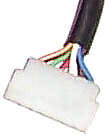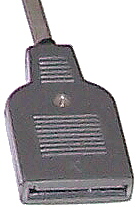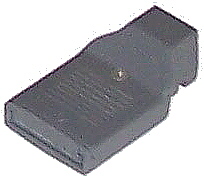|
|
 |
|
 |
 |
| The earliest
PETs had this type of data recorder built-in
but it was sold separately after the PET's
keyboard was improved. This model has no data
counter. |
The cream
version followed and is labelled as model
1530. It is like the black model except for
the addition of a tape counter. This made
it easier to find programs on the tape. |
 |
 |
| Mine is |
Mine are |
| Serial 054050
made in Taiwan. |
Serial 212920
made in Taiwan ROC. |
| |
Serial 299610
made in Taiwan ROC. |
|
 |
|
|
 |
|
 |
 |
| The 1530
was redesigned and this was the model bought
with most VICs and 64s. The plug for connecting
to the computer was improved. |
For the
C16 and Plus/4 the datassette was renamed
1531 and given a black case. The connector
was changed so that 1530s and 1531s could
not be interchanged but adaptors soon appeared
on the market. |
 |
 |
| Mine are |
Mine are |
| Serial 2103837
made in Taiwan ROC. |
Serial JA
0121329 made in Taiwan ROC. |
| Serial 2156009
made in Taiwan ROC. |
Serial JA
0248033 made in Taiwan ROC. |
| Serial JA05
45242 made in Taiwan ROC. |
Serial JA
0267014 made in Taiwan ROC. |
| Serial JO4
031232. |
Serial JA
0273527 made in Taiwan ROC. |
| Serial JO4
297361 made in Taiwan ROC. |
Serial XG
0060736 made in Taiwan. |
| Serial S
394393 made in Japan. |
Serial XG
0064704 made in Taiwan. |
| Serial S
0807889 made in Singapore. |
Serial XG
0160599 made in Taiwan ROC. |
|
 |
 |
 |
| Unlike many of
its competitors, Commodore prevented ordinary cassette
recorders being connected to its computers. Commodore's
own tape deck, known as a datassette, had a unique
connector. The idea of a dedicated cassette drive
was to make loading and saving more reliable. In
this, Commodore were probably successful but the
result was a long, long wait for a game to load.
In its defence, it has to be said that the datassette
was easy to use and usually worked well. The slow
speed of the tape was partly due to the software
or data being checked as it was loaded or saved. |
 |
 |
 |
 |
 |
 |
 |
| Early connector as used
on top two. |
Connector used on later
1530s (C2Ns). |
1531 connector for C16
and Plus/4. |
|
 |
 |
| Adaptor
to allow a 1530 (C2N) to be used with a C16 or Plus/4. |
 |
 |
 |
| Adaptor
to allow a 1531 to be used with a Vic-20 or C64. |
 |
| The real disadvantage
of using cassettes was in the storage and retrieval
of data. Any search had to be made from the start
of the tape. The answer of course was to use a disk
drive, but again only Commodore's own were compatible
and they were expensive. Most games came on cassettes
and blank tapes were readily available. The design
of the datassette evolved with each new computer.The
original 1530 works with the Vic, 64 and 128. The
16 and Plus/4 use the 1531. |
 |
|
|
| |
| |
| |
|
|
 |
|
 |
 |
| Entrepo
Model 8500 QDD |
Phonemark
Model 8500 QDD |
| Serial
number 012937 made in Taiwan ROC. |
Serial
number 001093 made in Taiwan ROC. |
|
 |
|
|
 |
| Microwafers
(Data drives and
wafers to same scale but not actual size). |
 |
|
A compromise between cassette tapes and disks,
the Quick Data Drive uses a continuous loop
of magnetic tape in a plastic case. This enables
programs and data to be searched for from
the current position without rewinding as
you would need to with a cassette and at random
like with a disk. The microwafer and its tape
are much smaller than a regular cassette. |
 |
|
The tape drive uses the datassette connector
on the 64. It can also be set up to work with
the VIC. The drive comes with its own operating
system (QOS) on a microwafer. Microwafer sizes
range from 16kb to 128kb. Drives can be daisychained
or used with a datassette. Microwaves should
be backed up as the tape can get entangled
in the drive and become unusable. |
 |
| With the
majority of games on cassettes, the Quick
Data Drive was not a great success. |
 |
|
|
 |
|